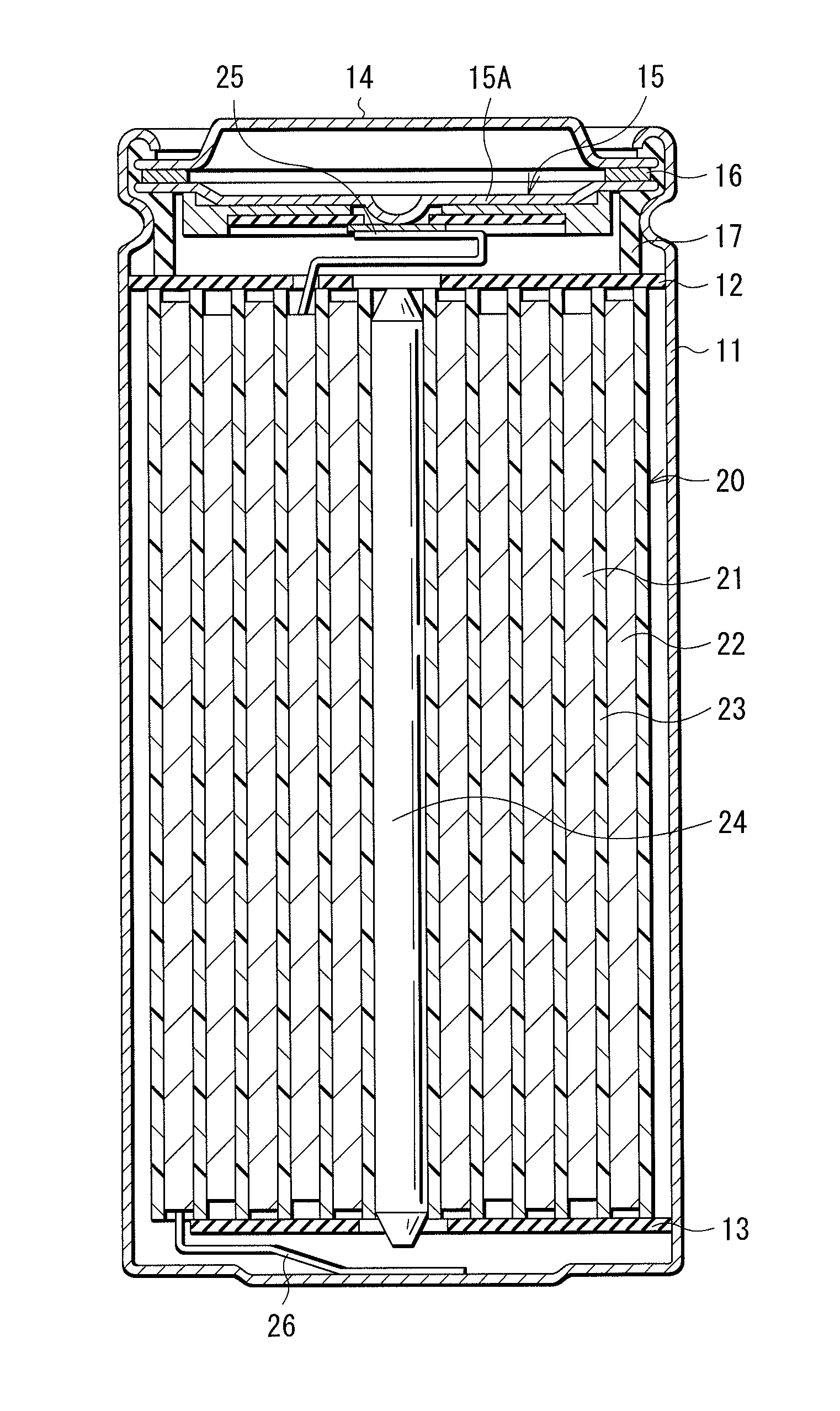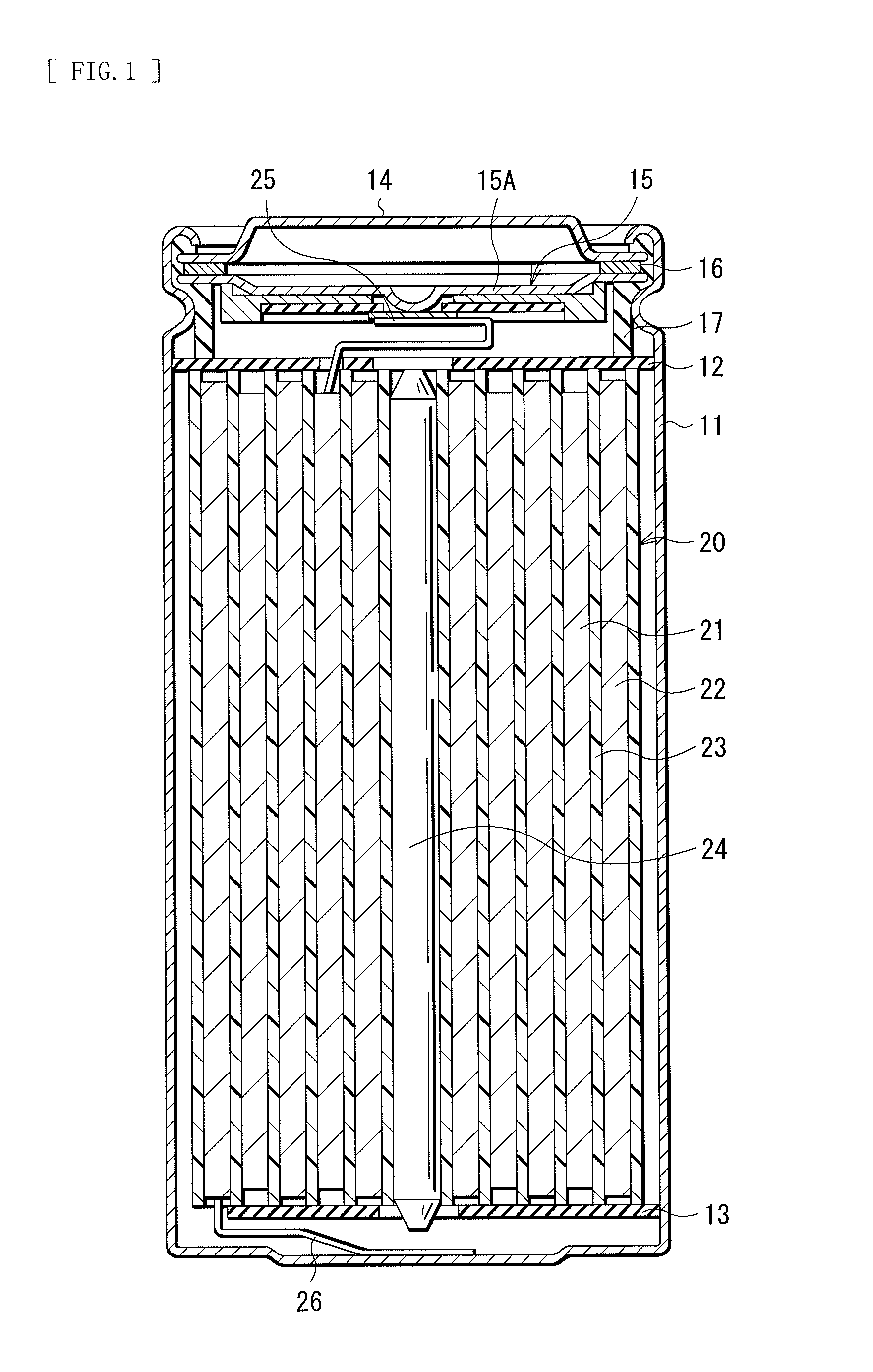Secondary battery, electrolytic solution, battery pack, electronic device, and electrical vehicle
a technology of electrolysis solution and secondary battery, which is applied in the direction of primary cells, non-aqueous electrolyte cells, electrochemical generators, etc., can solve the problems of frequent charge and discharge of secondary batteries, and achieve the effects of improving chemical stability, cycle characteristics, conservation characteristics, and load characteristics
- Summary
- Abstract
- Description
- Claims
- Application Information
AI Technical Summary
Benefits of technology
Problems solved by technology
Method used
Image
Examples
examples
[0256]Specific examples of the present invention will be described in detail.
first embodiment
1. Examples of First Embodiment
Examples 1-1 to 1-59
[0257]The cylindrical type lithium ion secondary battery illustrated in FIG. 1 and FIG. 2 was fabricated by the following procedure.
[0258]First, the cathode 21 was formed. In this case, first, lithium carbonate (Li2CO3) and cobalt carbonate (CoCO2) were mixed at a molar ratio of 0.5:1. After that, the mixture was fired in the air at 900 deg C. for 5 hours. Thereby, lithium-cobalt composite oxide (LiCoO2) was obtained. Subsequently, 91 parts by mass of LiCoO2 as a cathode active material, 6 parts by mass of graphite as a cathode electrical conductor, and 3 parts by mass of polyvinylidene fluoride as a cathode binder were mixed to obtain a cathode mixture. Subsequently, the cathode mixture was dispersed in N-methyl-2-pyrrolidone to obtain a paste cathode mixture slurry. Subsequently, both surfaces of the cathode current collector 21A were coated with the cathode mixture slurry by a coating device, which was dried to form the cathode a...
examples 2-1 to 2-39
[0269]Secondary batteries were fabricated by a procedure similar to that of Examples 1-3, 1-21, 1-39, and 1-51 except that the composition of the nonaqueous solvent was changed as illustrated in Table 5 to Table 8, and the respective characteristics were examined. In this case, the following nonaqueous solvents were used. That is, diethyl carbonate (DEC), ethylmethyl carbonate (EMC), or propylene carbonate (PC) was used. Further, vinylene carbonate (VC), bis(fluoromethyl)carbonate (DFDMC), 4-fluoro-1,3-dioxolane-2-one (FEC), or trans-4,5-difluoro-1,3-dioxolane-2-one (TDFEC), or cis-4,5-difluoro-1,3-dioxolane-2-one (CDFEC) was used. Further, propene sultone (PRS), succinic anhydride (SCAH), or sulfopropionic anhydride (SPAH) was used. The content of VC in the nonaqueous solvent was 2 wt %, and the contents of DFDMC, FEC, TDFEC, and CDFEC in the nonaqueous solvent were 5 wt %. In the case where FEC and VC or the like were mixed, the content of FEC in the nonaqueous solvent was 5 wt %,...
PUM
 Login to View More
Login to View More Abstract
Description
Claims
Application Information
 Login to View More
Login to View More - R&D
- Intellectual Property
- Life Sciences
- Materials
- Tech Scout
- Unparalleled Data Quality
- Higher Quality Content
- 60% Fewer Hallucinations
Browse by: Latest US Patents, China's latest patents, Technical Efficacy Thesaurus, Application Domain, Technology Topic, Popular Technical Reports.
© 2025 PatSnap. All rights reserved.Legal|Privacy policy|Modern Slavery Act Transparency Statement|Sitemap|About US| Contact US: help@patsnap.com



